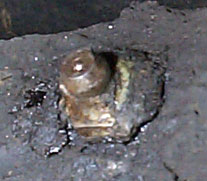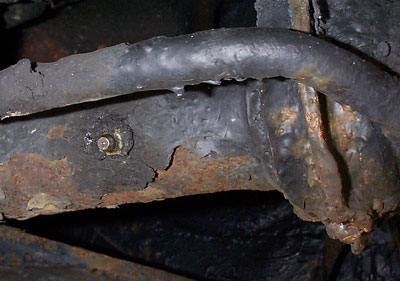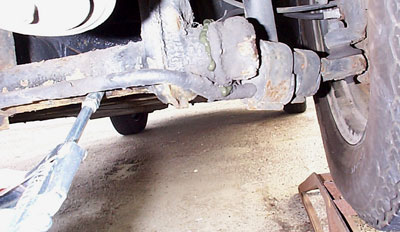Greasing the front axle on a Volkswagen Beetle
If you don't know when new grease was last added to the front axle of your VW Beetle, Bus or Karmann Ghia, it's a good idea to get hold of the bits and do it yourself. A decent amount of grease in there helps protect the steering components from rubbing against each other and causing unnecessary wear. After I'd done mine the steering felt slightly easier and more responsive, but this might have just been the psychological effect of having done the job. This page will tell you how to do it. It's a simple job, the instructions are quite long just because I'm trying to cover everything I could have done with when I was starting out. All these instructions and pictures are of doing it on my 1968 Beetle.
You will need:
- Grease gun
- Grease suitable for an axle, e.g. Halfords CM grease
- Wire brush or old toothbrush, or for the rich, a new wire toothbrush and metal teeth
- Newspaper or sheet of something to catch dripping grease
- Rag of some kind to wipe off grease
- Blanket / cardboard to lie on
- Gloves to stop your hands getting dirty
- You should be able to get to the front axle fine by lying on the floor, but if your Beetle or whatever is lowered then you might need to jack up the front somehow to get good access. In the pictures mine is up on ramps because I was fiddling with something else and it made it easy to take the pictures.
What's going to happen:
We're going to pump some fresh grease in to the two 'nipples' on the axle, until the old stuff starts leaking out of the ends. That's pretty much it.
How to do it:
Put your blanket on the floor in front of the car and lie down on it. Find the front axle (the long bar going from one side of the car to the other that the front wheels are attached to.) On the front axle will be two 'nipples,' one quite close to each end where all the brake gubbins and wheels are. See picture.
The nipple might be caked with all sorts of dirt from driving around over the years. You need to scrub this dirt off with the wire brush, or if you haven't got one of those a toothbrush. Knock all the dirt off and get it to a state where there isn't any dirt over the top, which is where the grease goes in.
Here's a picture of the grease nipple from another angle, with a bit of dirt left over from where I cleaned it:

The top bulge needs to be clean as the grease gun locks over it to pump the grease in. The grease 'nipple' is just a valve that will let the grease in, but not let it out again. The shiny bit in the middle of the fuzzy picture above is a ball bearing. When you pump the grease in, this will move to allow the grease through to the axle, and pop back in to position when you stop pumping to make sure the grease stays in the axle and doesn't get pushed back in to the gun.
Once the nipple is clean you need to fill your grease gun with grease. Mine unscrews at the nozzle end and you can put grease down the tube in a variety of ways - spoon (or suitable alternative) and just ladle it in, pour (likely a very messy business with most grease) or if you have a pot of grease with a big plastic washer in, you fit the open end of the grease gun over the gap in the plastic washer and push down, forcing grease in to the gun. You may need to be pulling back on the rod that pushes the grease forwards when the gun is full. This means you need about three hands, which is awkward when no one else is around, and why I don't have any pictures of the procedure. Hopefully if your grease gun is new it'll have instructions to help, otherwise keep fiddling with it until something falls off and it looks like it's the bit that'll take the grease.
Once the grease is in the gun, put the nozzle-end back on and pump the handle until some grease starts coming out of the nozzle. It's best to do this now so you don't try pumping air in to the axle. Grease everywhere? Good, now get down on the floor again and match up the end of the nozzle with the grease nipple on the axle. If the grease gun is anywhere near new (i.e. was made in the last ten years, or was just a decently designed one) it's probably got a little gap where the grease comes out which matches the shape of the nipple. This means you can push the nozzle over the nipple, making it easier to get the grease in to the axle rather than over the outside of it. Getting them fitted together can be a little tricky and you might need to press a bit harder than you expect, but if things start bending, ease off (especially if it's the axle, in which case you're the Hulk.) If the nozzle doesn't click over the nipple you'll just have to hold them firmly together and hope for the best.
Pump the handle of the grease gun, hopefully the rod that pokes out of the back of the gun will start moving inwards as grease is forced in to the axle. If grease is instead squirting everywhere under the car, either try again on locking the nozzle over the nipple, or swear a lot and think about who you could borrow another gun from (that's for greasing, not shooting the car, for any fiesty Americans out there.) Once the grease is going in have a look at the end of the axle nearest the nipple, at some point grease should start oozing out of the joint where the axle ends and the suspension starts, as below (apologies for poor pic.):
When grease oozes out around the joint, you've pumped in enough fresh grease. There might be a cracking sound before the oozing starts, which is the crust of dirt around the joint breaking. If you use all the grease in the gun and none has started oozing out of the end, re-fill the gun and keep going. This is a little worrying, but maybe you just didn't get much grease in the gun. If there was lots of grease in the gun and it all and more went in the axle it might be worth investigating if something has got corroded in there, because it should never get that dry.
If everything's gone well and you've got ooze like above, you can stop pumping. Clean off the grease that's come out with an old rag, and pull the grease gun off the nipple. This can actually be harder than getting it on, if it seems stuck try and make sure it's pointing directly away from the nipple, not at an angle, and keep on pulling. Wipe any grease off the nipple as well, but don't worry about wiping it all clean as a film of the stuff won't hurt the metal.
Now you're ready to do the other side, doing the same process all over again.
And that's it. You've greased the axle and it should be fine for another few years / thousands of miles. The whole job probably took longer than reading all this about how to do it.
Happy vdubbing

The best book for helping fix your old VW is
'How to keep your Volkswagen Alive' by John Muir
Buy it from these links to help me keep this site going:
Amazon USA or
Amazon UK

